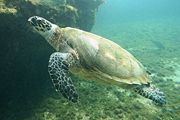
Marine reptile
Encyclopedia

Reptile
Reptiles are members of a class of air-breathing, ectothermic vertebrates which are characterized by laying shelled eggs , and having skin covered in scales and/or scutes. They are tetrapods, either having four limbs or being descended from four-limbed ancestors...
s which have become secondarily adapted
Adaptation
An adaptation in biology is a trait with a current functional role in the life history of an organism that is maintained and evolved by means of natural selection. An adaptation refers to both the current state of being adapted and to the dynamic evolutionary process that leads to the adaptation....
for an aquatic
Aquatic animal
An aquatic animal is an animal, either vertebrate or invertebrate, which lives in water for most or all of its life. It may breathe air or extract its oxygen from that dissolved in water through specialised organs called gills, or directly through its skin. Natural environments and the animals that...
or semi-aquatic life in a marine
Marine (ocean)
Marine is an umbrella term. As an adjective it is usually applicable to things relating to the sea or ocean, such as marine biology, marine ecology and marine geology...
environment
Natural environment
The natural environment encompasses all living and non-living things occurring naturally on Earth or some region thereof. It is an environment that encompasses the interaction of all living species....
.
The earliest marine reptiles arose in the Permian
Permian
The PermianThe term "Permian" was introduced into geology in 1841 by Sir Sir R. I. Murchison, president of the Geological Society of London, who identified typical strata in extensive Russian explorations undertaken with Edouard de Verneuil; Murchison asserted in 1841 that he named his "Permian...
period during the Paleozoic
Paleozoic
The Paleozoic era is the earliest of three geologic eras of the Phanerozoic eon, spanning from roughly...
era. During the Mesozoic
Mesozoic
The Mesozoic era is an interval of geological time from about 250 million years ago to about 65 million years ago. It is often referred to as the age of reptiles because reptiles, namely dinosaurs, were the dominant terrestrial and marine vertebrates of the time...
era, many groups of reptiles became adapted to life in the seas, including such familiar clades as the ichthyosaur
Ichthyosaur
Ichthyosaurs were giant marine reptiles that resembled fish and dolphins...
s, plesiosaur
Plesiosaur
Plesiosauroidea is an extinct clade of carnivorous plesiosaur marine reptiles. Plesiosauroids, are known from the Jurassic and Cretaceous Periods...
s (these two orders were once thought united in the group "Enaliosauria," a classification now cladistically obsolete), mosasaur
Mosasaur
Mosasaurs are large extinct marine lizards. The first fossil remains were discovered in a limestone quarry at Maastricht on the Meuse in 1764...
s, nothosaur
Nothosaur
Nothosaurs were Triassic marine sauropterygian reptiles that may have lived like seals of today, catching food in water but coming ashore on rocks and beaches. They averaged about in length, with a long body and tail. The feet were paddle-like, and are known to have been webbed in life, to help...
s, placodont
Placodont
Placodonts were a group of marine reptiles that lived during the Triassic period, becoming extinct at the end of the period. It is believed that they were part of Sauropterygia, the group that includes Plesiosaurs...
s, thalattosaur
Thalattosaur
Thalattosaurs are a group of prehistoric marine reptiles which lived during the mid-late Triassic Period. Some species of thalattosaur grew to over 4 meters in length, including a long, flattened tail used in underwater propulsion...
s and thalattosuchia
Thalattosuchia
Thalattosuchia is the name given to a clade of marine crocodylomorphs from the Early Jurassic to the Early Cretaceous that had a cosmopolitan distribution. They are sometimes colloquially referred to as marine crocodiles or sea crocodiles, though they are not actually members of Crocodilia.The term...
ns.
After the mass extinction at the end of the Cretaceous
Cretaceous
The Cretaceous , derived from the Latin "creta" , usually abbreviated K for its German translation Kreide , is a geologic period and system from circa to million years ago. In the geologic timescale, the Cretaceous follows the Jurassic period and is followed by the Paleogene period of the...
period, marine reptiles were less numerous. Extant marine reptiles include marine iguana
Marine iguana
The Marine Iguana is an iguana found only on the Galápagos Islands that has the ability, unique among modern lizards, to live and forage in the sea, making it a marine reptile. The Iguana can dive over 30 ft into the water. It has spread to all the islands in the archipelago, and is...
s, sea snakes, sea turtle
Sea turtle
Sea turtles are marine reptiles that inhabit all of the world's oceans except the Arctic.-Distribution:...
s and saltwater crocodile
Saltwater Crocodile
The saltwater crocodile, also known as estuarine or Indo-Pacific crocodile, is the largest of all living reptiles...
s.
Some marine reptiles, such as ichthyosaurs and mosasaurs, rarely ventured onto land and gave birth in the water. Others, such as sea turtles and saltwater crocodiles, return to shore to lay their eggs. Some marine reptiles also occasionally rest and bask on land.
See also
- List of marine reptiles
- salt glandSalt glandThe salt gland is an organ for excreting excess salts. It is found in elasmobranchs, seabirds, and some reptiles. In sharks, salt glands are found in the rectum, but in birds and reptiles, they are found in or on the skull, in the area of the eyes, nostrils or mouth. In crocodiles, the salt is...

